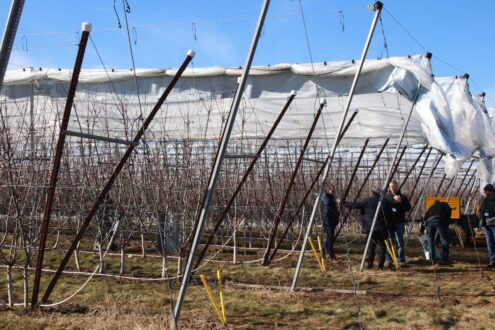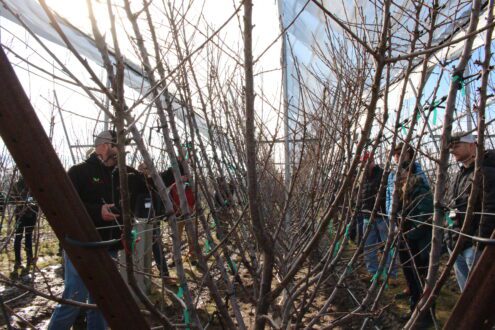

Apr 11, 2023Serve and protect: Riveridge cherry protection boosts crop
Editor’s note: This article is an expanded version of the article that appeared in print.
Commercial sweet cherry production is particularly challenging in the Midwest and Northeast regions of the U.S., including in Michigan where a prominent grower-packer-shipper is innovating its approach to produce a profitable crop.
During the 2023 International Fruit Tree Association’s (IFTA) annual convention and tours, in Grand Rapids, Michigan, nearby Riveridge Produce Marketing showcased a covering system it is using on the Fruit Ridge to protect cherries from rain cracking.
The company has been growing cherries for 14 years.


“Over the last few years we’ve been really trying multi-leader systems,” said Riveridge operations manager Justin Finkler. “We’ve got our multi-leader V-systems, regular V-systems and free-standing systems. We’re trying to find the variety and system that works for us.
“We are going forward to cover all of our current production,” Finkler said. “We are designing trellis systems that we can go in and permanently install in future plantings.”
Surveying what other growers have experienced and working with Michigan State University horticulture professor Greg Lang, who’s been studying covering systems for specialty crops for more than 15 years, Riveridge believes it has found the right formula for its operation.
“A half hour of rain, and it’s gone.”
In 2022, the company contracted with Germany-based Voen Covering Systems to develop the infrastructure and netting system for what will eventually make up more than 100 acres at Riveridge’s Grant, Michigan, property.
Rain is the biggest factor in using the netting.
“You can get the best crop that you’ve had in in 10 years and a half-hour of rain and it’s gone,” Finkler told a tour group during the February IFTA event. “There’s nothing you can do about it. There’s no byproduct that you can get any money out of.”
Rain forecasts can force growers to pick cherries a few days before yields are maximized or fruit quality is the best, he said.
Finkler said Riveridge is following Voen’s suggestion to install heaters under the covers. Twenty heaters per acre can raise the temperature 6-7° Celsius with the cover system. The first heaters will arrive this year.
“We’ll have about 15 acres of cover going up just for frost this season,” he said.
Other benefits include eliminating bird damage by using side netting, and deploying the system early can make the conditions more consistent during the bloom period to aid pollination.
Covered trees seemed to exhibit less bacterial canker and leaf spot than non-covered adjacent rows, Finkler said.
One of the late varieties Riveridge grows is Sweetheart.
“In the past it’s been very difficult for us to even get that to where we can deliver it to the package shed because it crops really heavy and it clusters, so it doesn’t size very well,” he said. With the cover, fruit can mature and grow without worrying about cracking.
“We were able to get that to market and it was a pretty good eating piece of fruit,” he said. “It sets every year so I think Sweetheart is a variety we know we can set.”
Pollination can also be managed effectively under the covers.
“I think if we had these covers last year before all of that heat, we could have lengthened that pollination window and would have had a better set,” Finkler said. “It’s always going to be weather dependent. It seems like we get one curve swing really one direction one year and one another direction the next year.”
“With having this system it’s going to take us a few years to maximize all of the benefits to it or learn how to use them. At least this puts us to where we have a shot to have a crop most years.”
The block featured on the tour was planted in 2018, with Skeena cherries on Gisela 5 rootstock, trained to a V trellis.


“With this soil, we’re a little heavier on this side of the block but as you go to the south here it gets to be really sandy so probably in a four-leader system we could have made this have a little more vigor,” he said. “This hasn’t had a crop on it the last two years because of frost. The trees are really growing to the top this year and there’s some blind wood in the center so we need to try to get some fruit set in here.”
Finkler said the best angle with the V-trellis structure is the grower’s preference.
“Being at a 12-foot spacing, obviously the more toward vertical the better they’ll grow upright. We are moving to a little bit steeper V, a little tighter at the top. We’re going to try to tighten the rows to 10 feet and steepen the V.”
New plantings this year will be on an upright fruiting offshoots (UFO) system.
“I think we’re going to struggle with renewing some of the blind spots in this (current) number of leaders. Looking at what the UFOs have been able to do in renewing the whole shoot, longevity wise, that’s going to be a better plan for us.”
Other sweet cherry varieties Riveridge grows include Benton, Attika, Regina, Burgundy Pearl, Black Pearl and Ebony Pearl, along with a few test trees of Tamara, Royal Helen and Royal Hazen.
Design of the cover
According to Voen, the coverings provide protection from frost, hail, wind and sunlight, along with insect control. The coverings are situated at the top cable during winter and don’t need to be taken down until it’s time to replace them. They generally last eight to 10 years.
“The difficulty here was putting all of this stuff in around a structure and trees that were already up,” Finkler said of the initial Riveridge installation. “It’s definitely very much not efficient trying to do it that way. A vertical tree and a trellis would be one thing, but having an angle with the V, and having to build a machine to go around it, we learned our way through that pretty quickly.
“We have reengineered our trellis that will go in at planting at a time to be set for covers as the production comes years later. We have worked through that and are going in the right direction.
Riveridge has deployed the Voen system in 45 to 60 mile-an-hour wind gusts.
“The way it’s louvered allows the wind through,” he said. “We haven’t seen any ripping or tearing. It’s pretty structurally sound.”
Finkler said the system’s lifespan depends on how long it is deployed.
“If you are just using it for the weeks you are concerned about rain, and the rest of the time it was wrapped up, it would probably last longer,” he said. “We’ll have it out during the frost season. I don’t know what we’ll have for the time in between, if we’ll take it down or leave it back up. We’ll probably play around and figure out what we can do to try to save the material and get the most bang for our buck.”
After the system is installed, Finkler said a crew of six can cover four to five acres a day. Riveridge’s system here has zippers; the system with clips takes a little longer to deploy.
The concern with the zipper versus the clip system, Finkler said, is that weight from hail could damage it.
“We’ve decided to go with the zippered based on time and efficiency of getting it out and back in,” he said. “We’re going to run the risk of catching the hail but I think if we don’t get something excessively normal it will take it and we will be fine with these.”
— Gary Pullano, senior FGN correspondent
Top photo: Ultimately, more than 100 acres of Riveridge Produce Marketing sweet cherries will be under cover, offering protection from frost, hail, wind, sunlight and pests. Photos: Gary Pullano














